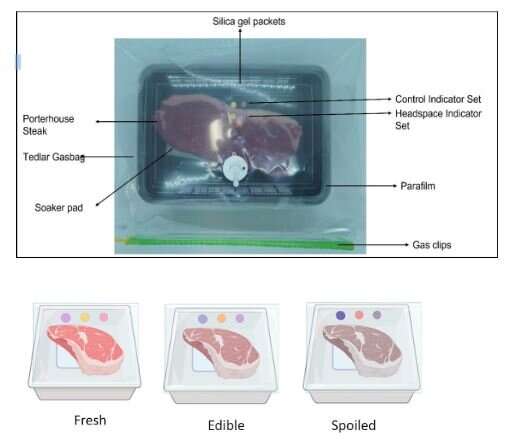This article has been reviewed according to Science X's editorial process and policies. Editors have highlighted the following attributes while ensuring the content's credibility:
fact-checked
trusted source
proofread
Packaged-meat labels that show freshness could replace use-by dates, reducing food waste

Patches that change color as raw meat freshness deteriorates in sealed refrigerated products could soon become a reality on supermarket shelves, making it easier for shoppers to know if it's still good to eat and reducing food waste.
The innovative approach, developed by Monash researchers, uses on-pack color indicators made from natural plant materials to show how fresh the beef is right at the moment.
The findings are published in the journal Food Quality and Safety.
The researchers, led by former Monash University Ph.D. student Debarati Bhadury (now at the University of Washington in Seattle), believe their method could reduce the amount of meat thrown away when it's still safe to eat based on the "best before" stamp.
Using beef porterhouse steaks, the research demonstrated that when applied to the inside of transparent packaging film, the indicators consistently changed color in response to rising pH levels caused by growth of bacteria such as E. coli.
Machine-readable versions could also become a possibility, helping to automate aspects of the supply chain and retailing, such as price discounting as freshness changes, and the technology is also likely to be extensible to other fresh foods.
The patches, co-developed by Dr. Joanne Tanner, of the Department of Chemical and Biological Engineering at Monash, who supervised the research with Professor Kellie Tuck of the School of Chemistry, were made from a combination of nanocellulose and dyes found in vegetables like red cabbage and black carrot.
"Color-changing indicators on the package are a way of giving consumers real-time information that meat is still fit for consumption," Dr. Tanner said.
"By contrast, a 'best before' date merely represents a conservative estimate of how long the packaged meat will remain usable and is not an actual gauge of freshness. It is based on a series of worst-case assumptions about its handling and refrigeration through the supply chain."
"This means meat is often returned or disposed of when it is actually still fit for consumption."
Dr. Tanner said the color indicator system could also be linked through smartphone apps to provide consumer advice, suggesting optimal ways to cook and prepare meat based on freshness.
"Smartphone integration providing advice on food preparation is a real possibility using this freshness indicator. For example, the meat could still be consumed but should be cooked for a longer period rather than eaten rare," Dr. Tanner said.
The study also showed that bacterial counts differed on steaks with the same best before date, further highlighting the value of an on-pack indicator.
Dr. Tanner said a combination of two or more color-changing sensors was likely to be best for consumer use, as it would account for individual differences in color vision.
Next steps in the research program will be to extend the findings by investigating a number of other anthocyanins that show color changes across different pH ranges and may be suitable for different fresh foods.
More information: Debarati Bhadury et al, Application of On-Pack pH Indicators to Monitor Freshness of Modified Atmospheric Packaged Raw Beef, Food Quality and Safety (2024). DOI: 10.1093/fqsafe/fyae021
Provided by Monash University




















